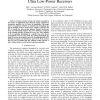Free Online Productivity Tools
i2Speak
i2Symbol
i2OCR
iTex2Img
iWeb2Print
iWeb2Shot
i2Type
iPdf2Split
iPdf2Merge
i2Bopomofo
i2Arabic
i2Style
i2Image
i2PDF
iLatex2Rtf
Sci2ools
71
Voted
PIMRC
2010
IEEE
2010
IEEE
Optimal transmission rate for ultra low-power receivers
In many wireless systems, the energy consumed by the receiver is significantly larger than the energy consumed by transmitter, possibly even by orders of magnitudes. This paper derives an analytical solution to maximize the throughput per unit of available receiver circuit power. Adaptive control of the IP3, to handle the time-varying adjacent channel interference level, can substantially improve the power efficiency, compared to the common practice of design for worst case. There appears to be an optimum throughput at a specific (non zero) power consumption level. For large SNR, the optimal throughput per Joule of receiver circuit power occurs for a modulation rate of 2.3 bits/s/Hz, irrespective of interference power level. If the receiver has less power available than the optimum setting requires, a duty cycling scheme can still achieve optimum operation.
Related Content
| Added | 14 Feb 2011 |
| Updated | 14 Feb 2011 |
| Type | Journal |
| Year | 2010 |
| Where | PIMRC |
| Authors | J. H. C. van den Heuvel, Jean-Paul M. G. Linnartz, Peter G. M. Baltus |
Comments (0)

